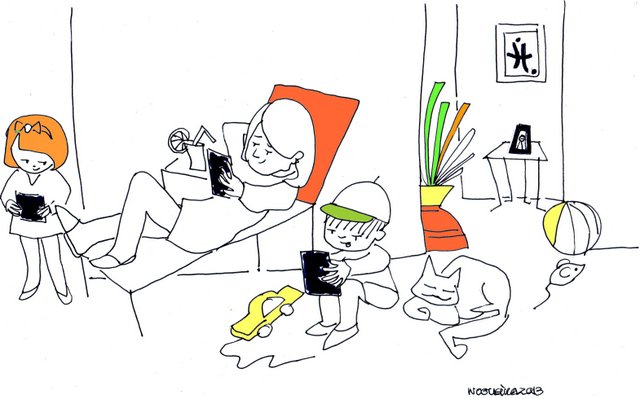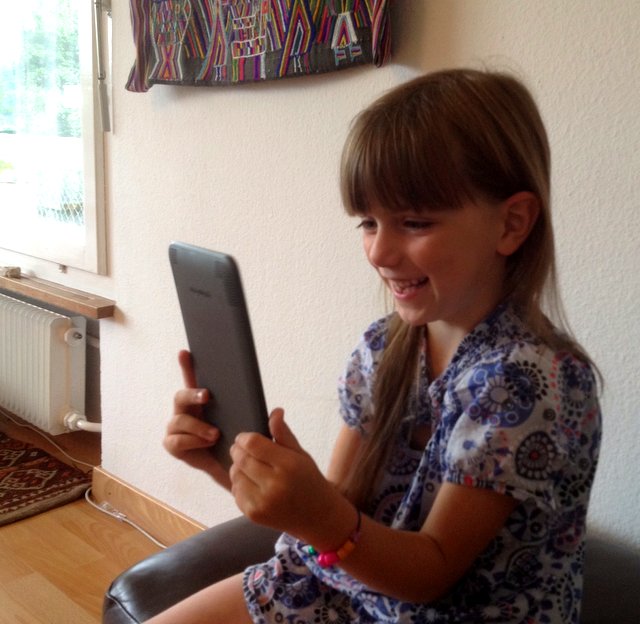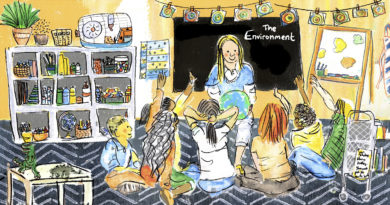Print or Kindle? That is the Question
I lent a friend of mine a book recently. She said she liked it, and then she gave it back – said she was still reading it on her Kindle. Said she prefers reading on the Kindle to reading the printed version…said I should really try it. This came as a surprise to me, because this friend seems to be generally quite old-fashioned in her outlook on life; she’s sort of homespun and relaxed. So how could this be true? I know some people use Kindle or other electronic reading devices when they are travelling, but to curl up with a Kindle at night by the fire seemed odd to me.
She told me some of the benefits of the Kindle: the books and magazines cost less, can be ordered at any time, take up less room, and can be shared within the same family; fonts can be adjusted or highlighted for better viewing, etc. I have heard about the environmental issues involving e-readers, and I wondered about those. I also began to wonder how children viewed the e-reader and how it affected comprehension and love of reading, so I did a little research and came up with a few answers – very few, to be more exact.
Printed-book enthusiasts tend to believe that their system of reading is better for the environment, and according to Slate magazine, the production of one Kindle is harder on the environment than the production of one book. Producing a single book generates 7.5 kilos of carbon dioxide, while a single iPad generates 130 kilos of carbon dioxide in its manufacture (a Kindle’s waste production is thought to be even higher). However, when we look at the statistics of how many books are bought and downloaded and used during an e-reader’s lifetime, the statistics begin to favor electronics. Clearly, we don’t buy an e-reader for just a few books. In fact, people tend to buy more e-books than printed ones.
The amount of water used in the printing of books is actually more than that used in electronic reading devices, provided the electronic device is used for over 12 books. However, e-readers are criticized because of the non-renewable minerals needed to run them and for the exploitation of the laborers employed to retrieve those components from mostly third world countries. This is a serious problem, and entrepreneurs from Fairphone are working on a smarter, fairer model of smart phone. (See the Fairphone website for details.) If their products are successful, perhaps a fair e-reader will follow. Next, what about the problem of rubbish? Actually, more energy is used in recycling and assigning unwanted books to the landfill than is used in disposing of electronic e-readers.
If you still want to stick with turning the paper pages, according to Slate, the best things to do are to purchase your books online (which avoids book shipments to individual shops and away from them again if the books are not sold) or to visit your local library. Oddly enough, one can often borrow an e-book at the library as well, which somehow seems to defeat the purpose! Also, in my opinion, a trip to a bookshop is an enjoyable event, and the shops employ a good amount of people, so new jobs would have to be created elsewhere in the business of books.
What About Children?
According to Student Comprehension of Books in Kindle and Traditional Formats, written in 2011 by Michael Milone Ph.D., a study involving 31 fourth-grade students in the U.S. was undertaken to compare children’s understanding of 135 books. The study used computerized testing that showed that there is no significant difference between students’ comprehension of the Kindle version and the print version of the books. The study did show, however, that children preferred reading on the Kindles. As the use of the Kindle in the classroom is just beginning to take hold, it is not sure if this is a case of the novelty effect or if these results will hold true in future studies. This study mirrored the results of previous studies, but a larger amount of students and books were employed than in previous studies.
Other studies report that most young readers prefer using e-readers to printed books. Larson (2009) reported that fifth-grade students were highly engaged by the tools that let them interact, take notes and highlight texts. She found that second-graders liked using e-readers, and she concluded that the “findings suggested that using digital reading devices with second-grade students promotes new literacy practices and extends connections between readers and text as engagement with and manipulation of text is made possible.” (“Digital readers: The next chapter in e-book reading and response.” The Reading Teacher, 64, 15–22.)
According to Milone’s review of literature, most kids interviewed said that they would rather read a book on a Kindle than a paperback book. Interestingly, children read printed books slightly faster than they read on Kindles.
With the aforementioned results, parents and teachers can feel somewhat assured. We hope that our children become lifelong readers, and from the studies’ results, it seems that the use of the Kindle and other e-readers does not hinder children’s reading comprehension. In addition, the fact that their use seems to instill a love of reading in children makes it all the more uplifting.
While perusing a page about kids’ Kindle products on Squidoo, I learned a few things about the products’ features. There are so many to choose from, and kids can do much more than read stories on them. It is mind boggling for me, a printed-book fan. One interesting feature that can be found on some kids’ Kindles is Immersion Reading. This feature allows synchronization of the printed word with a voice track, which is certainly a great resource both for kids who are learning to read and for reluctant readers. Of course, there are screen sizes, parental control options and Internet preferences that must be considered as well.
I grew up with a bedtime story every night, so printed books have always been my point of reference. I liked looking carefully at the colorful pictures and even listening to the sound of the pages turning. I liked placing the bookmark in the books that I read to my children and enticing them with the first page of the new chapter. These are the practices that I am familiar with, but it looks like today’s young families are going to have a different experience. The use of Kindles and e-readers is a reality that is just now taking root. Clearly our grandchildren’s relationship with books will never be the same as our own. What do you think about e-book devices like the Kindle? Are you ready for the future?
By Mary Bider
Mary is an American transplant who has three grown children. She works as a primary school teacher, where she tries to keep up with all the new technology used in education; only sometimes does she have to ask the kids!
Illustration by Albina Nogueira. Picture by Tammy Furey.






So far, we are sticking to paper books. The problem we’re facing is space. Having an own library would be just great. Not all books we like to read can be found in libraries, definitely not the ones written in my mother tongue. And not all the kids books can be found on Kindle. We will wait, what the future brings us.
True, e-readers are great for expats. We can get books in our mother tongues in any country that we happen to hang our hats!
I like the in-built dictionary and translation possibilities of e-books especially when reading in a second or third language. My son who is a 12 year old who loves BIG books up to 700 pages long, says he now prefers paper books. But he likes series of books and in order to get through them in order he is delighted if he finds them in any form rather than waiting for an order at a bookshop.